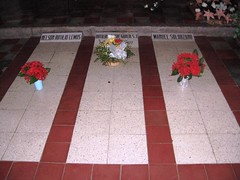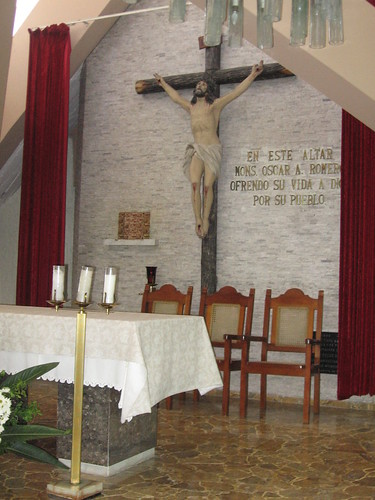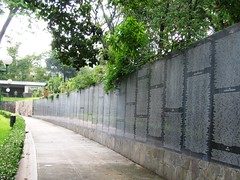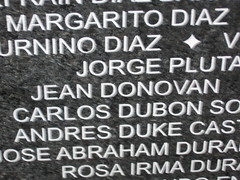So begins the introduction to an article by Jon Sobrino, SJ in the anthology, We Make the Road by Walking. It was in this spirit of hopeful remembering that our little delegation visited some of the holy sites of the martyrs of El Salvador.
 We visited the Chapel in El Paisnal where Jesuit Father Rutilio Grande is buried, along with his two companions. The story of Rutilio Grande’s work and friendship with Oscar Romero is depicted in the film “Romero.” He was assassinated in 1977 along with 72 year old Manuel Solorzano and 16 year old Nelson Rutilio Lemus as they were driving along a country road on their way to mass.
We visited the Chapel in El Paisnal where Jesuit Father Rutilio Grande is buried, along with his two companions. The story of Rutilio Grande’s work and friendship with Oscar Romero is depicted in the film “Romero.” He was assassinated in 1977 along with 72 year old Manuel Solorzano and 16 year old Nelson Rutilio Lemus as they were driving along a country road on their way to mass. In San Salvador we visited "El Hospitalito," the Divine Providence Hospital where Monseñor Oscar Romero was killed. The hospital is run by the Carmelite Sisters who provide hospice care to the poor. Carmelite Sister Lydia shared the story of Monseñor Romero's friendship with the Sisters and his "pueblo" - both relationships based on love and humanity.
In San Salvador we visited "El Hospitalito," the Divine Providence Hospital where Monseñor Oscar Romero was killed. The hospital is run by the Carmelite Sisters who provide hospice care to the poor. Carmelite Sister Lydia shared the story of Monseñor Romero's friendship with the Sisters and his "pueblo" - both relationships based on love and humanity. We listened to her storytelling in the same Chapel where Romero was killed while saying Mass in 1980. On the wall behind the Altar are these words: "At this altar Monseñor Romero offered his life to God for his people. " She showed us the small sacristy behind the altar where Monseñor Romero lived so simply as Archbishop until the Sisters built him a little house on the grounds. He called it a "palace."
We listened to her storytelling in the same Chapel where Romero was killed while saying Mass in 1980. On the wall behind the Altar are these words: "At this altar Monseñor Romero offered his life to God for his people. " She showed us the small sacristy behind the altar where Monseñor Romero lived so simply as Archbishop until the Sisters built him a little house on the grounds. He called it a "palace."  We also visited the "Monumento a la Memoria y la Veridad" - a wall of names at Parque Cuscatlan in San Salvador. It is reminiscent of the Vietnam Memorial and includes the names of the 75,000 non-combatants who died during the war years. The names are grouped by year from 1981 to 1992 when the Peace Accords were signed.
We also visited the "Monumento a la Memoria y la Veridad" - a wall of names at Parque Cuscatlan in San Salvador. It is reminiscent of the Vietnam Memorial and includes the names of the 75,000 non-combatants who died during the war years. The names are grouped by year from 1981 to 1992 when the Peace Accords were signed. Included on the wall are the 4 American Church Women who were kidnapped, abused and murdered in 1980: lay missioner Jean Donovan, Maryknoll Sisters Maura Clarke and Ita Ford, and Ursuline Sister Dorohy Kazel. One entire panel lists the names of all the "Niñas y Niños" - boys and girls - who were killed.
Included on the wall are the 4 American Church Women who were kidnapped, abused and murdered in 1980: lay missioner Jean Donovan, Maryknoll Sisters Maura Clarke and Ita Ford, and Ursuline Sister Dorohy Kazel. One entire panel lists the names of all the "Niñas y Niños" - boys and girls - who were killed.We weren't able to visit the University of Central America - where the Jesuits Ignacio Ellacuria, Segundo Montes, Juan Ramón Moreno, Ignacio Martin Baro, Armando Lóopez, and Joaquín López y López, were killed in 1989, along with their housekeeper Elba Ramos and her 15-year old daughter Celina Ramos. The campus was fittingly closed for the feast of "El Salvador del Mundo." Jon Sobrino narrowly escaped that fateful day, as he was out of the country for a speaking engagement. Needless to say, he has offered many reflections on the Martyrs over the years. In the article I quoted at the beginning of this post he says of the act of remembering:
It exhorts us to live more for one another and provokes us to a commitment to truth, peace and justice. It compels us to be more human. It maintains hope in the midst of so much enchantment.Needless to say, the combined experience of walking on holy ground was (and continues to be) powerful. As I wrote in my journal:
I find myself listening to this all in my heart. My heart where God dwells and where I dwell in God. Where the suffering of humanity and all creation dwells, and where there also dwells hope of the new dawn where all are one. I wonder, and I pray ... how will I live into this challenge, this call, this story? How will I be changed and transformed in the process?
4 comments:
Lovely and moving post, Susan. One correction - Jean Donovan wasn't a Marynoll lay missionary but a lay volunteer affiliated with the Cleveland diocese. At least you got she wasn't a nun. It always irks me when media refers to the "four US nuns murdered in El Salvador."
Terry
Thanks Terry. The error was the result of some a poor cut & paste job on my part.
It is now corrected! :)
I'm enjoying your series. :)
It certainly can be challenging to transform suffering & tragedy into hope, vs. into cynicism, or despair. I wish I had that all figured out :) I've seen glimpses of it before...
Post a Comment